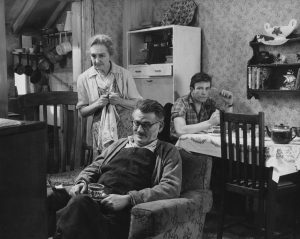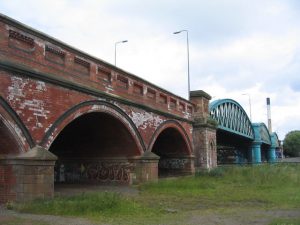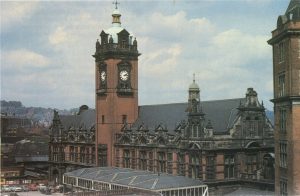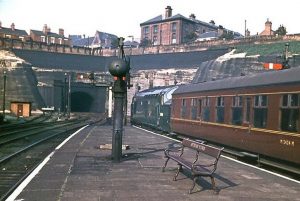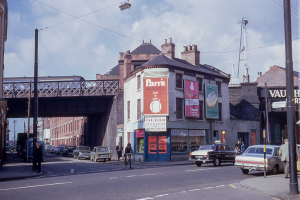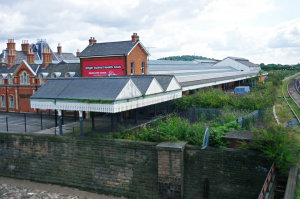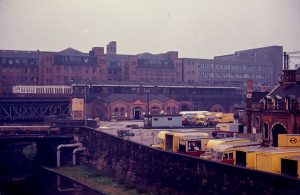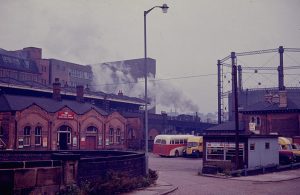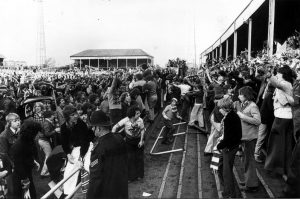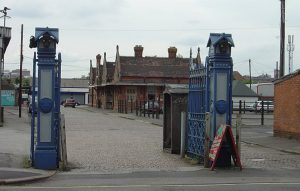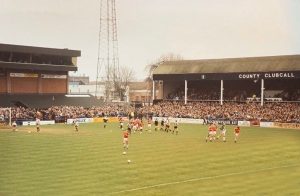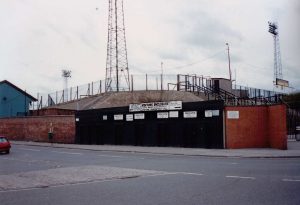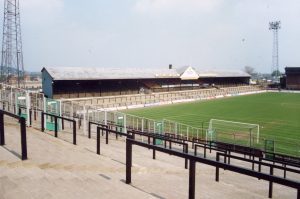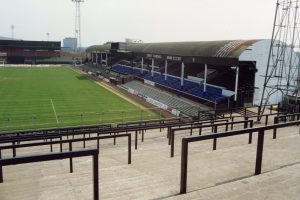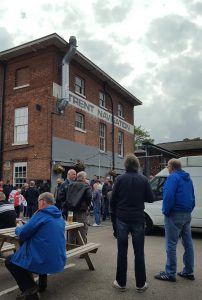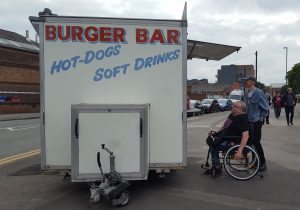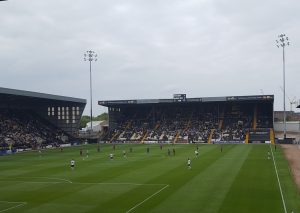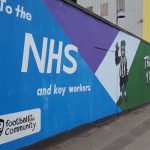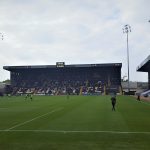Notts County 3 Aldershot Town 2
National League
Saturday 4 September 2021

County lines
The context
No-one needs any particular reason for visiting Notts, do they? Our first post-Covid outing chose itself. A trip to the Lane – which always manages to remind you what football once was, and always should be – felt exactly what we had been missing.
The history
Meadow Lane is built on archaeologically layered social, cultural and footballing heritage. This ranges from Alan Sillitoe’s kitchen sink dramas – “Notts County had beaten the visiting team” causes boozy celebration in Saturday Night and Sunday Morning, while another darker story sees one man terrorise his family after a 4-0 defeat against Bristol City – to the accumulated sporting memories of 112 seasons here.
Notts had already been playing football for 42 years when they left Trent Bridge cricket ground in 1910. The Meadows district – tightly-packed terrace streets, extending beyond London Road to form a congested triangle from which only the Trent Navigation pub survives – crowded their new home on its westerly side. This site nevertheless felt far less cramped than now. Water meadows lined the Trent; a small river followed its northern boundary, flanked by extensive allotments and Nottingham’s new cattle market.
Railway companies built the Meadows and many railway workers lived there. No fewer than five lines intersected Meadow Lane. The first – starting at Melton Mowbray – ran over Lady Bay Bridge before joining London Road Junction. Sneinton level crossing came next; two Great Northern Railway bridges followed, one which served the original terminus at London Road (Low Level) station and another from Grantham passing through London Road (High Level) en route to Nottingham Victoria. A final bridge accommodated goods trains using the big yard between Sneinton Hermitage and Lees Hill Street.
- ornate
- cutting (Brian Johnson)
- Arkwright Street, 1967 (Brian Jeyes)
Victoria station’s ornate frontage – unforgiveably demolished when the Victoria shopping centre was built – concealed palatial booking-office facilities and no less than twelve platforms in a deep cutting. Long access tunnels still survive beneath city centre streets. One runs northwards under Mansfield Road; its counterpart emerges at Weekday Cross, where Grantham trains curved away towards High Level. The Manchester-Maryleebone route (now partly used by trams) traversed Midland Station before heading south through the Meadows via Arkwright Street viaduct.
- Low level, 2009 (John Huddlestone)
- High Level and Low Level, 1966 (Brian Jeyes)
- High Level, 1966 (Brian Jeyes)
Much of Nottingham’s nineteenth-century railway infrastructure was dismantled after Victoria closed in 1967. Low Level’s station building survives as a gym but everything else has gone, including numerous other viaducts, High Level’s elevated platforms and Henry Boot’s drugs factory (“Boot’s Island”) behind. The old Meadows also disappeared; Notts, however, belied their neighbourhood’s wholesale destruction during twelve remarkable years that saw Jimmy Sirrel win three promotions and take them into the First Division.
Fans – even those too young to remember him – are fiercely proud of Sirrel’s legacy and the succession of well-balanced teams he thoughtfully created. His straightforward plain speaking, tactical skill and kindly wisdom characterised Notts County for a generation. All these attributes helped no end when Manchester United won promotion from the Second Division in 1975 and visiting hooligans celebrated by trashing Meadow Lane. County player David McVay described (in Steak…Diana Ross) how Jimmy armed himself with the physio’s scalpel and had to be dissuaded from single-handedly taking them on.
The journey
Nottingham is much easier by road since the Remembrance Way bypass was completed. Parking proved less straightforward. Our favoured cattle market option looked deserted; much futile driving about – that even saw us vainly circuiting Trent Bridge – ensued before I lost patience and signed up for one of those ring-this-number street parking schemes. Twenty irritating minutes later we walked round a corner to find everybody else merrily leaving their cars in the now open cattle market.
The ground
We sat behind the Meadow Lane goal. This fronts a sports hall built following Notts’ 1981 promotion. Executive boxes above us once perched high up on bare bricks, which in turn replaced a charmingly ramshackle stand brought here (by river) from Trent Bridge. Athough all four stands date from the early Nineties they are of different sizes and designs. One – on the County Road side – has been named after Jimmy Sirrel and reproduces its predecessor’s famous triangular gable.
- Kop end
- County Road
- Main Stand (bomb damage visible on roof)
(all pictures by Bob Lilliman)
That sports hall left the ground with only three sides until basic standing accommodation was eventually added underneath. Nothing else changed much in eight decades. Peak capacity of 50,000 – only ever achieved once – derived mostly from extensive terraces at the Kop end and County Road side. Kopites stood on cinders until 1981, while those along County Road could enjoy wooden steps supported by stilts above the culverted River Leen. Meadow Lane’s original Main Stand remained unaltered apart from World War 2 bomb damage, a precarious-looking 1970s-era TV gantry and some extra blue plastic seats.
Flesh and wine
As usual we resolutely avoided Hooters (judging by their testosterone-fuelled state many Burberry-clad Hampshire youths didn’t). Meadow Lane is almost in the city centre; there are plenty of drinking opportunities about, but the Trent Navigation passed our “nearest the turnstiles” test and has extensive boozing space outside. A quick stroll past Jimmy and Jack Wheeler’s statue and that was us sorted.
Finding food challenged us more. Covid regulations meant counters in the narrow Meadow Lane end concourse remained shut, although fans could access al fresco ones between here and the Derek Pavis Stand. I didn’t need them, though, having already bought a hot-dog outside. “Traditional” says everything you need to know.
The game
Notts were fourth and started well against struggling Aldershot. They had already seen a goal disallowed before Callum Roberts outfoxed three defenders and set up Kyle Wootton’s delicately placed finish from just inside the box. But despite more pressure the visitors broke to equalise just before half-time, Corie Andrews taking advantage of midfield hesitation when he slid home Lewis Kinsella’s long punt forward.
Things soon got worse as Kyle Cameron fumbled another long ball and Andrews burst forward to finish cleanly past Sam Slocombe. This lead, however, lasted just two minutes; Cameron then made amends by rising above the entire Aldershot defence and heading in an inch-perfect corner just in front of us. Roberts next curled Notts’ eventual winner from Ruben Rodrigues’ neat back-heel and desperate defending somehow kept them ahead, while Cameron saw what would have been their deserved fourth wrongly ruled out for offside.
- County boundary
- post-Covid
- Jimmy and Jack
- style
- stile
- corner view
- gable friend
Teams and goals
Notts County: Slocombe, Cameron, Lacey (Rawlinson 75), Palmer, Taylor, Brindley (Mitchell 46), Kelly-Evans, O’Brien (Francis 82), Roberts, Rodrigues, Wootton. Unused subs: Sam, Chicksen.
Aldershot Town: Walker, Kinsella, Lokko, Berkeley-Agyepong (Watts 85), Whittingham, Lyons-Foster, Edser, Andrews (Willard 77), Akanbi (Auoachria 68), Phillips, Harris. Unused subs: Oxlade-Chamberlain, Hall.
Goals: Notts County: Wootton 38, Cameron 52, Roberts 64. Aldershot: Andrews 44, 50.
Attendance 5921.


